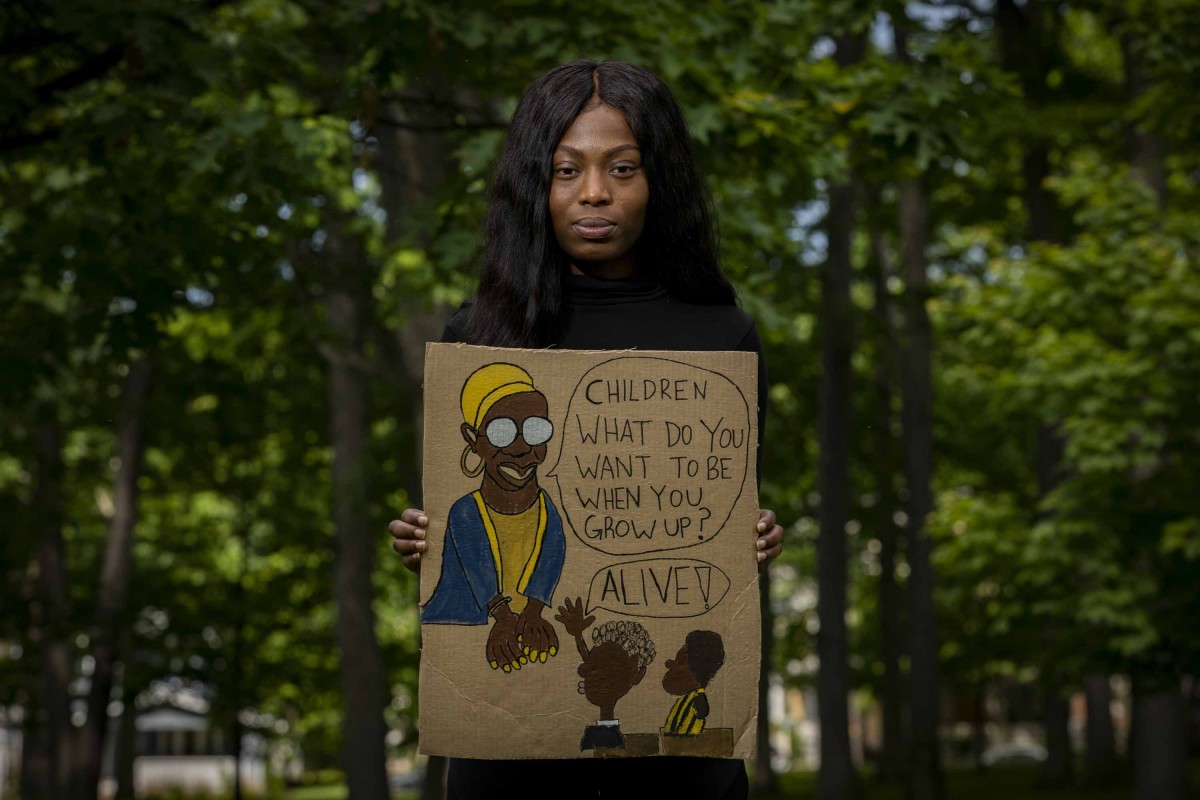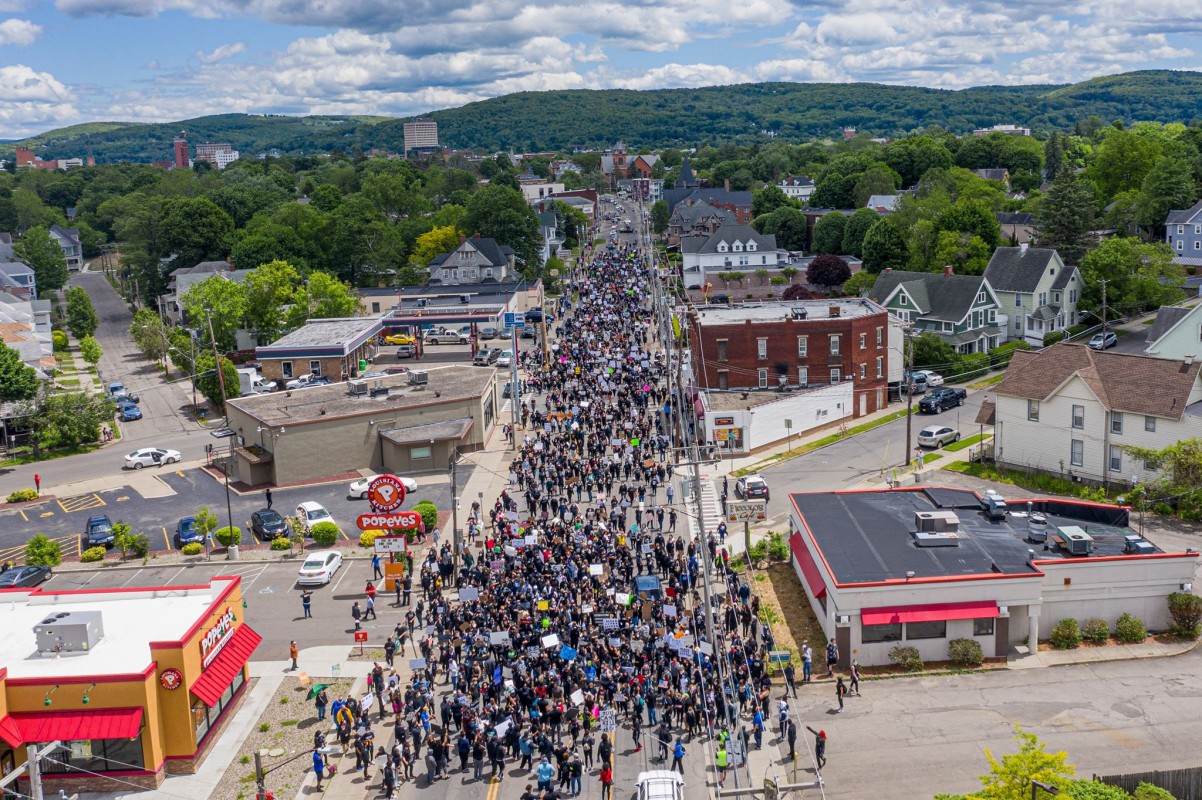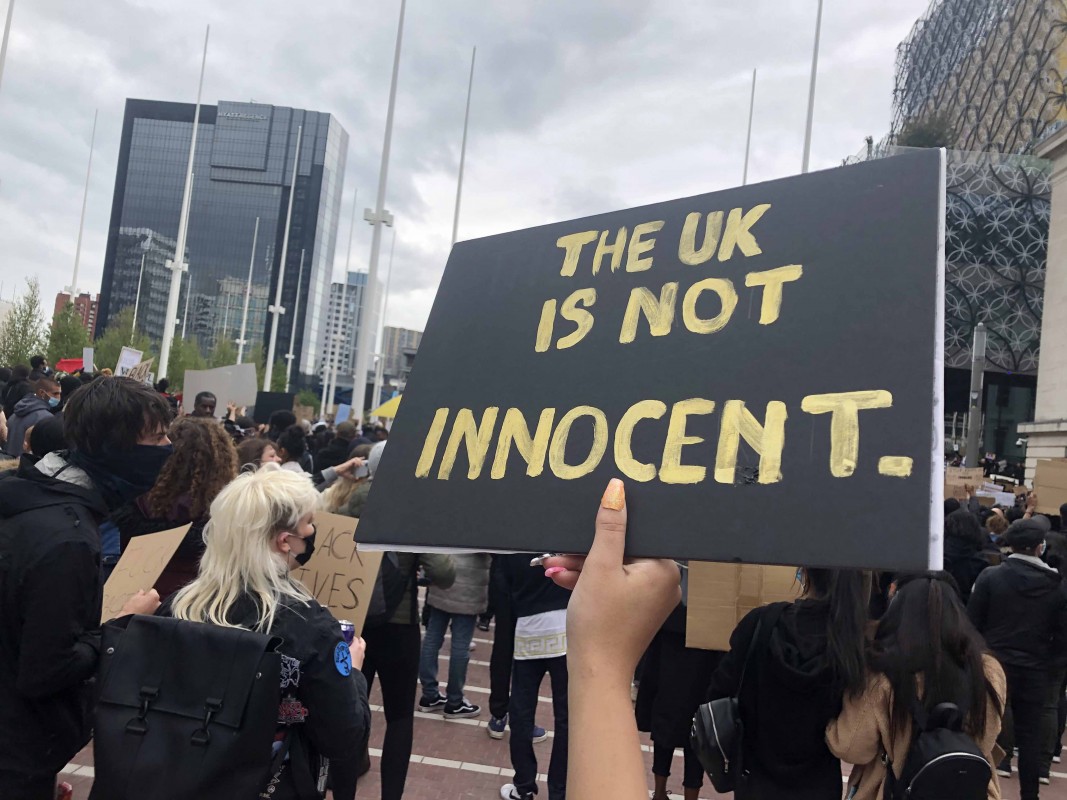History in the making: Binghamton takes part in Black Lives Matter protests

George Floyd’s life mattered — long before a wave of protests swept the globe, long before his agonizing death under the knee of a Minneapolis street cop. What if we all recognized that basic human significance, the core of the principles enshrined in the U.S. Declaration of Independence that say all men are created equal, and entitled to the pursuit of life, liberty and happiness?
“Just think: What a different world we could have had. It would have been impossible for these police officers to do what they did,” reflected Binghamton University History Professor Anne C. Bailey, director of the Harriet Tubman Center for the Study of Freedom and Equity. The bedrock principles of the country itself would have rendered such an act unthinkable, regardless of personal prejudice, she said.
Protest has shaped American history and society, from the Boston Tea Party to the Civil Rights movement. Binghamton students, faculty and staff have joined the unfolding events, participating in Black Lives Matter protests both in the Southern Tier and around the world — risking their health during a pandemic to speak out against racial inequities and police brutality.
Among them is graduate student Veronica Agyapomaa, who has participated in Binghamton-area marches. A second-year student in the social work program, she is no stranger to participating in and organizing protests, starting when she founded the African Student Union at her Syracuse high school.
As both a social worker and a black woman, she sees the need to address the systemic injustice in America. Fellow Bearcats have joined her in the streets, as well as students from Binghamton High School, where she recently interned.
“As a social worker, it is my duty to effect change, no matter what form it takes,” she explained.
Also joining one of the Binghamton marches was Sharon Bryant, an associate professor in the Master of Public Health program, as well as director of the University’s Collegiate Science and Technology Entry Program, the Upward Bound Math-Science Program and diversity, equity and inclusion for Decker College of Nursing and Health Sciences. Accompanying her was her 15-year-old son.
Protest is a family tradition, and the cause close to her heart. Bryant has roots in Alabama, and her parents, aunts, uncles and grandparents all participated in the Civil Rights movement. As a student at Howard University, she participated in marches in the 1980s in support of making Martin Luther King Jr.’s birthday a national holiday.
“I can remember the excitement of being out there as a community, working toward a common goal,” she said. “I wanted my son to have the experience of being out in the marches.”
Bryant has spoken to her son about the potential for police brutality many times through the years, starting when he was in kindergarten; it inspired a poem she wrote for the Harriet Tubman Center. As a mother, that necessity stings — along with the realization that a childhood free from the specter of violence wasn’t truly possible for her son and other children of color.
“I want to be able to send my son out into the world boldly and fearlessly, but I am cautious because I want him to understand the realities,” she said. “I would love for him to be seen as who he is, not just his gender and the color of his skin.”
On the other side of the Atlantic, English Professor Thomas Glave is also participating in protests. He lives in Birmingham in the United Kingdom, and typically teaches classes on the Binghamton campus only during the fall semester.
At marches in Birmingham and London, Glave joined thousands of people — many of them teenagers — from diverse backgrounds. He marched alongside young Muslim women wearing hijabs, young men and women both black and white, all shouting ‘Black lives matter!” he recounted. Overall, the protests were “peaceful, orderly and angry,” but without the aggressive police action seen in the United States, he said.
“I was fascinated — actually stunned — that thousands of nonwhite people participated in these protests throughout the U.K., and — at least as far as I’ve seen — we weren’t confronted by police with nightsticks and in riot gear, or using tear gas, or threatened by helicopters flying low, trying to intimidate us, at least not yet,” he said. “It was really humbling seeing so many young people, and people not young, of all colors and ethnicities, giving their all. It actually restored some of my faith in humanity.”
Historical roots
While the current protests may have been sparked by recent events — the deaths of George Floyd, Breonna Taylor and Ahmaud Arbery, for example — their roots lay much deeper in the American past.
“As a historian, I don’t think so much in terms of this year, or the past 10 years; I think in terms of hundreds of years, and it sometimes helps you to feel more hopeful,” said Bailey, the author of books including The Weeping Time: Memory and the Largest Slave Auction in American History.
She writes “history from below,” focusing on the perspective of ordinary individuals — people like plantation slaves Jeffrey and Dorcas, slated to get married in 1859, a few scant years before the start of the Civil War. The issues behind the protests anchor in 1787 — the start of the Constitution, which codified a different vision than the one in the Declaration of Independence, one that limited the idea of free citizenship, and determined that a person of color was worth only three-fifths of a white man, property and not a person.
During the Civil War, almost 200,000 Colored troops literally fought for freedom, Bailey noted. Southern blacks, deprived of citizenship, voted with their feet from the very start of the war, heading en masse for the Union line. The abuses of the Jim Crow period, the Civil Rights movement — each thread connects with that central concept of “all men are created equal,” in both achievement and failure.
“There’s been this long march toward full equality and full freedom. It’s very much been a history from below,” Bailey said.
Like the United States, racial prejudice in the United Kingdom roots in a deeper history, but one subtly different. Plantation slavery was outsourced to the colonies, but the wide reach of the British Empire led to the later immigration of people from the Caribbean and South Asia — which some nativist British found a point of contention.
While white Brits remark on “racial problems” in the United States, they’re not always eager to look at problems in their own country, observed Glave, who is Jamaican-American. White nationalist groups exist there, as does police brutality, a deeply entrenched class system and a right-wing Tory government whose prime minister, Boris Johnson, has made overtly racist remarks in the past.
Changing the future
Not everyone is physically able to protest, particularly during a global pandemic, Bailey acknowledged. In her blog, Baileyblog, she suggested multiple ways to contribute to the cause, drawing on lessons from the Civil Rights movement. They include boycotts; sit-ins, teach-ins and read-ins; freedom rides; voter registration drives; citizenship education classes; letter and media campaigns; photography; writing and performing in solidarity; fundraising and donations; holding vigils and memorials; and, of course, marches.
“Don’t just focus on the marches; those will come and go,” she said. “There are so many different ways to participate.”
Bryant strongly supports access to education and is the director of several grant-funded programs with outreach to Binghamton and Johnson City schools. She is a first-generation college student herself, and has seen firsthand how higher education can transform a family’s trajectory. It’s a message she hopes to instill in today’s young people, particularly those who may consider college out of reach.
Ultimately, creating a more equitable society needs to start with each of us, in our homes and our workplaces.
In higher education, that means going beyond diversity audits and implementing real measures to make sure that faculty and the administration are representative of the population, and compensated fairly both in terms of time and service requirements. Diversity is more than checking off a box, Bailey noted; it exposes people to different perspectives, and to the inherent worth of individuals from different backgrounds.
Will today’s protest movement make the history textbooks of the future? Considering the crowds willing to protest even in a pandemic and the international scope, Bailey thinks it will.
Agyapomaa agreed.
“This is history in the making, and we all want to be on the right side of history,” she reflected. “This is something you can talk about with your grandchildren someday.”



